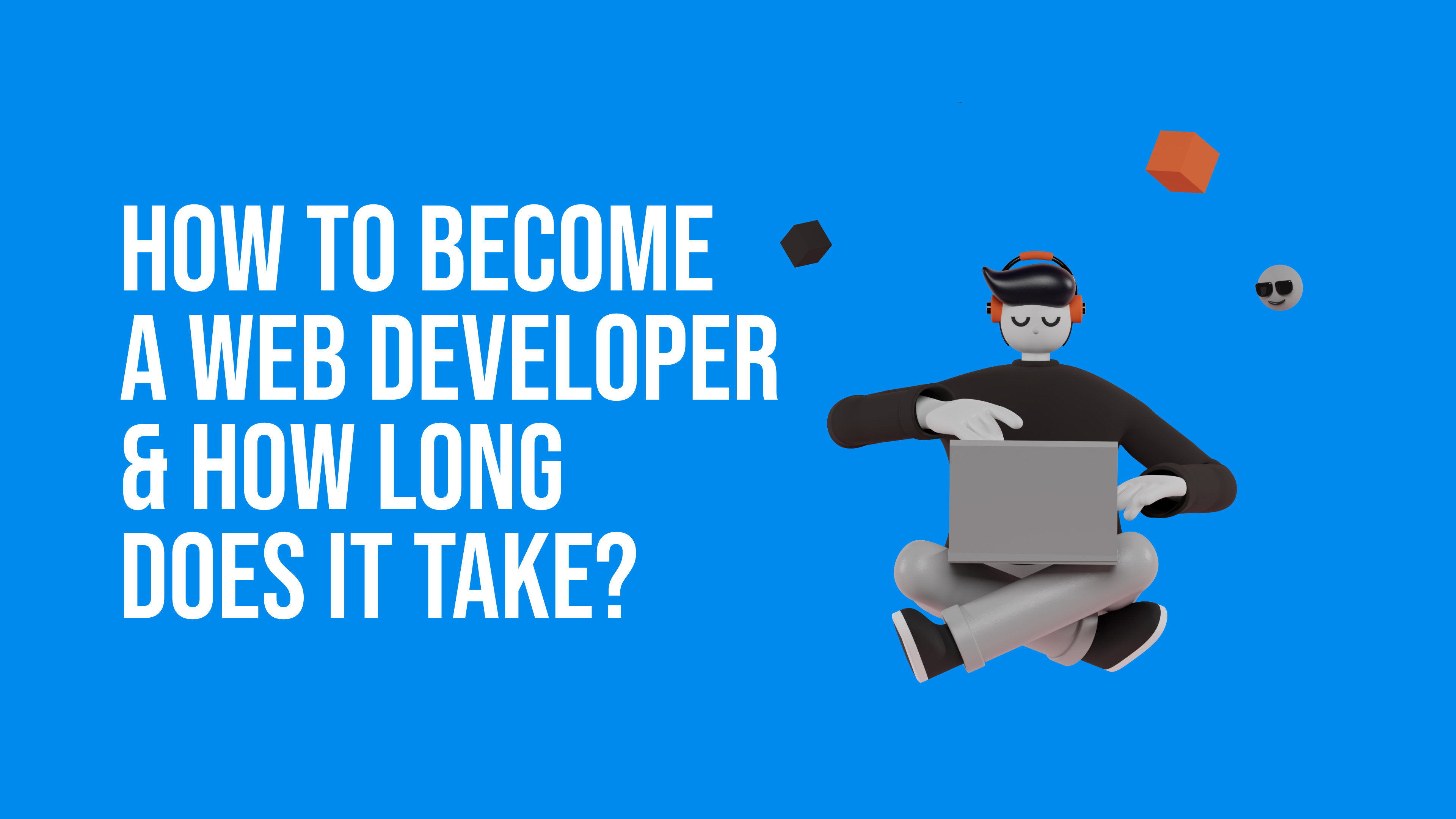The internet contains more than 1.8 billion websites as of the time of writing. When you open a browser tab, type in a URL, and press enter, a website will load. The site might contain text, images, buttons, a navigation menu, and many more elements. You interact with it for a specific purpose and get relevant information from it. The people that are responsible for creating such functional and interactive websites or web applications are called web developers. In this blog, we will explore what web development is, what web developers do, and more importantly how to become one.
First, what is web development?
Web development is the process of building websites and applications for the internet. Web developers are at the forefront of the internet. All the static web pages, social media sites, eCommerce websites, games, content management systems (CMS) have been built by web developers. Web development can be broken down into three main concentrations: front-end, back-end, and full-stack development.
Front-end development is the process of creating the part of a website or application that interacts directly with the user. The front-end of a website is also popularly called the ‘client side’. Everything that you see when you’re navigating around the internet, from fonts and colours to dropdown menus and sliders, is a combination of HTML, CSS, and JavaScript being controlled by your computer’s browser. Front-end ensures that a website or web application is functional (serves a purpose) and responsive (appears neatly irrespective of the size of the user’s screen).
So, in short, front-end development is the process of creating the structure, design, behaviour, and content of a website or application.

Where front-end is everything a user sees and interacts with, in a website, back-end is everything that goes on behind the scenes. It refers to the server-side of an application. It includes all the code needed to build the database, server, and application and the communication between the database and the server. Back-end developers build and maintain the technology that powers these components. They enable all the user-facing aspects of a website to exist.
Some examples of back-end processes are an account login, purchasing an item from an online store, accessing any data from the database, file uploads, and downloads, storing and updating data in a database, etc.
Full-stack is front-end and back-end together. Developers who have skills in both client-side and server-side development are called full-stack developers.
Steps to Becoming a Web Developer:
- Learn the fundamentals
The very first step to becoming a web developer or anything for that matter is research. Research your field of interest. Read articles, watch videos, interview web developers, talk to friends and ask for help from your teachers. It sucks if you’re two months into learning a programming language and realize it is not for you. Or worse, you lose all interest and motivation to carry on. So, do thorough research on web development.
Find out all the languages you need to learn, all the frameworks you need to be familiar with, and how you are going to learn to code. Lucky for you, this article is all about what web development means and what you will need to become a developer. So, you can check the first box.
- Choose an area of specialization
Next, choose an area of specialization. As we mentioned earlier, web development involves front-end and back-end development. To develop any digital product, website, mobile application, games, user interfaces, etc. these two are more or less what you can choose between. Check out our blogs on front-end development and back-end development to learn in more detail.
- Learn Key programming languages
Whatever your area of concentration, you will need to be familiar with a handful of programming languages for web development and web design. The very basic, crucial ones that you will need in virtually all aspects of web development are:
- HTML (Hypertext Markup Language)
- CSS (Cascading Style Sheet)
- JavaScript
Of course, there are many more. Web development is a vast and diverse field. The more you learn, the more you need to learn. But these three are key when starting out. Fish out web development vacancies and note down the requirements. Through this, you can find out what skills are required to work in a real working environment. Then, work your way through learning the basics.
- Apply what you’ve learned- Create your own projects

With an understanding of HTML, CSS, and JavaScript, and a foundation in programming skills, you are ready to begin building a real project. You learn coding the best through the application. So, everything you have learned, use it to create a website. Replicate a simple website that already exists, or create your own. The more you mess around, the more proficient you will become.
- Launch a professional portfolio
With some experience up your sleeve and a handful of creative projects, launch a professional portfolio for yourself. Your portfolio can act as your resume. Or you can direct people here when applying for jobs. But, this doesn’t have to be the most complicated thing. You can simply introduce yourself, highlight your skills, and add relevant information. If you have diversity in your projects, that is the best. Through your portfolio site, you have to be able to convince employers that you are organized, detail-oriented, learned, experienced, and good at problem-solving. Demonstrate your strengths and communication skills.
Would you be willing to hire yourself for a project solely based on this portfolio? Make sure the answer is yes.
- Seek opportunities yourself
Hopefully, after all of these steps, you have learned several languages, worked on projects individually, even better yet, in a team. You are ready to work as a developer. But, job opportunities don’t come uninvited. Put yourself out there. Check for vacancies on different platforms daily. Build a network with like-minded people. You can learn if some positions are open somewhere through them.
Sign up to become a freelancer. There are so many platforms that connect employers with freelancers. The beginning may have some friction, but with determination and advertising your skills, you can land a project in a short time. Apply for all kinds of jobs that you can find relevant within your field. All your work experiences will add up and boost your career further down the line.
This is basically how to go about web development. Let’s talk about some tools that you will need in this process.
- A computer: This is a no-brainer. If you want to learn to code, you can’t do that on paper. You don’t need the savviest device. A computer that you can deal with will work fine for learning. Although to work in real projects, you will need to upgrade.
- A place to learn: you don’t need to go to college or special classes to learn web development. Although, if you do, that’s good; except they don’t really teach you that in school. So, you’re kind of on you’re own.
Decide how you are going to learn. There are many options. Youtube has full courses on almost every programming language out there. You can learn more from a YouTube video than you will in an entire semester really. So, yeah. There are learning platforms like Udemy, Skillshare, Coursera, etc. If you can afford to pay for subscriptions, this is a good idea. The conventional method would be through books, but learning to code through books seems counterintuitive, so maybe stick to the Internet. If you can read this blog, you have all the resources you need.
- Text editor: You need a text editor to write code. You can use Sublime or Visual Studio. You need a web browser like Chrome or Firefox. Write code in the editor, go live and see how it looks on a browser page. You can find information on how to download and set up a text editor on YouTube. There are also full guides on how to use them.
- Git: Git is a version control system that lets you track changes to a file. It is so important in any development project, that not being familiar with is a disadvantage. You can store and manage code, and revive older versions if anything goes wrong during your work. It is really helpful to get familiar with it.
- GitHub: GitHub is the cloud interface for Git. It offers some functionality of Git plus its own; bug tracking, task management, etc.
Learn more about Git and GitHub here.
- Design tools: It is also a tremendous advantage if you are familiar with design tools. In real working environments, before starting the actual development project, you will need to present a brief layout of your digital product. So, if you design a website layout through graphic design tools, it is so much easier to implement it with code. You can start with Photoshop, Illustrator, and Sketch.
- You will also require a sound understanding of SEO (Search Engine Optimization).
- And lastly, you should be able to document your project and communicate it with people regardless of their technical background. Good communication skills are important for a collaborative effort in real workspaces.
Finally, how long does it take?
How long it takes for you to learn web development from scratch depends on the resources you use and how much you learn. For some, it takes around 5 to 6 months, while others take over a year. If you spend only a few hours studying every day consistently for 6 months, you can get an entry-level job, or an internship within this time.
Companies hire novice developers to train and groom them. Even as a student or a working person, you can work as soon as you get the opportunity. You learn more working in a team on real projects than alone. And if not that, you can work remotely as a freelancer for anyone around the world. It depends on you how much you can learn and grow.
As a developer, you need to be willing to learn more. There are new languages, frameworks, and tools every day. You have to constantly stay updated. Learning never stops as a developer or anyone in the technical field. The web development industry is lucrative, secure, and exciting. Almost all resources you need to become a developer are readily available on the internet, most times even for free. So, if the idea of creating a robust digital product through algorithms and code excites you, you should learn to develop right away. Find a crash course on YouTube or buy sessions on learning platforms, and get started right away.

